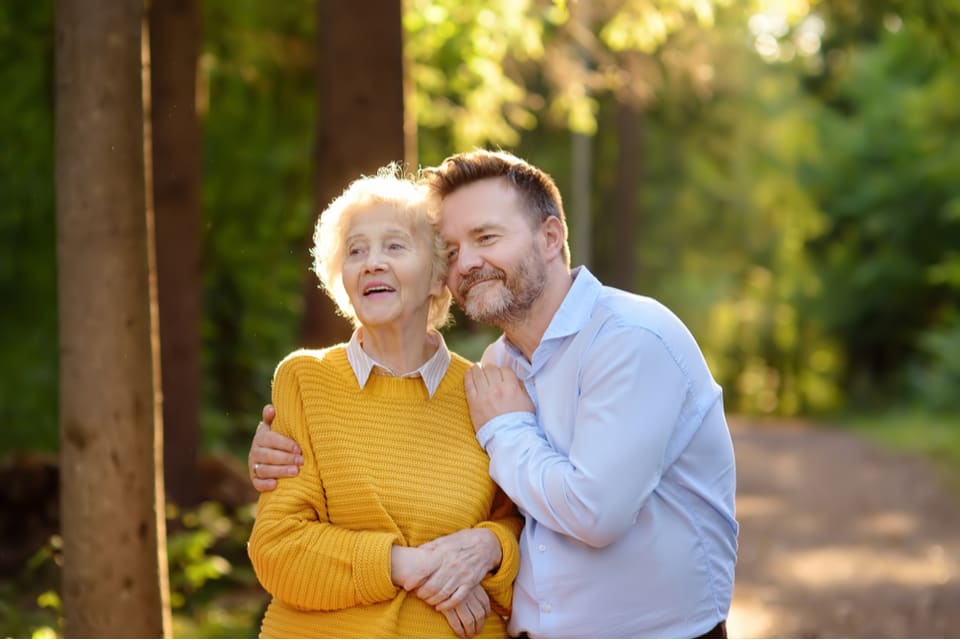
Gender Differences in Caring for Aging Family Members

Women make up 60% of all family caregivers in the U.S., according to research from the Family Caregiver Alliance. This significant percentage represents a longstanding norm. And, caregiving duties affect everything from women’s health to their finances, with women caregivers providing an estimated $188 billion in unpaid services each year. However, the norm is shifting. The American Association of Retired Persons (AARP) found that more than 14 million men currently act as family caregivers.
Let our care assessment guide you
Our free tool provides options, advice, and next steps based on your unique situation.
Jon Strum, host of the podcast RealTalk MS, became a member of this growing male caregiver population more than 20 years ago when his wife received a multiple sclerosis diagnosis. Now, his podcast inspired by this experience reaches thousands of listeners. Through this platform, Strum says he hopes to advocate for caregivers and illuminate their increasingly diverse and complex stories.
“When I realized I was going to become a caregiver, I had no idea what that would entail,” says Strum. “We need to let guys know that they’re not alone and that there are resources in place to help them succeed in this role.”
The likelihood that someone turning 65 today will require some form of caregiving in their lifetime has surged to 70%, according to the U.S. Administration on Aging. Going forward, Strum views figures like these as a sure sign that more men will need to get involved in a family member’s care.
“So many more families are going through this experience. More often than in the past, these responsibilities are going to fall on the man in a relationship or in a family.”
Read on to learn about why families often expect women as primary caregivers, plus how both genders can challenge this assumption to create a more equitable future.
How does the gender imbalance in caregiving affect women caregivers?
The prevalent connection between women and caregiving carries significant consequences. A study of 1,611 family caregivers published in “The Journals of Gerontology” found that women caregivers devoted more hours to caretaking labor than their male counterparts did, intensifying their caregiving burden in several areas. This increased input in family care has a striking effect on the health, mental well-being, finances, and relationships of women caregivers.
Health effects of women and caregiving
Caregivers are more likely to experience mental and physical health conditions compared to the general population. These already troubling outcomes weigh more heavily on women caregivers, in particular. In the “Journals of Gerontology” study, women reported anxiety, depression, and cognitive dysfunction at higher levels than men.
Additionally, a greater caregiving burden can compromise women’s physical health. Specifically, female caretakers are at higher risk of developing coronary heart disease and high blood pressure. Their increased responsibilities and time commitments often take on a toll on preventative health services as well. Women who provide care for an aging parent often skip out on mammograms and on filling their own prescriptions, according to research from the Family Caregiving Alliance.
Financial effects of women and caregiving
Though family caregiving comes with steep costs for everyone involved, women disproportionately shoulder these financial repercussions. Women who assume a caretaker role often suffer the following economic effects:
- Lower wages
- Fewer comprehensive benefits
- Reduced work hours, including a shift from full-time to part-time employment
- Lost Social Security benefits
- Diminished retirement funds and pensions
In more extreme cases, 16% of women caregivers quit their jobs altogether. After leaving the workforce, the stark difference in financial well-being between male caregivers and their female peers continues: On average, women caregivers see $40,000 less in total retirement savings.
Relational effects of women and caregiving
With life expectancy continuing to rise, more families find themselves in the position of both caring for aging parents and raising young children. Women’s unpaid labor is at the crux of this “sandwich generation” crisis.

Let our care assessment guide you
Our free tool provides options, advice, and next steps based on your unique situation.
In addition to dedicating more time to a parent’s care, women on average contribute 42% more time to parenting than their male partners do, according to the U.S. Bureau of Labor Statistics. These competing duties often leave women feeling inadequate or overwhelmed in both spheres.
Caregiving can also strain marriages and romantic partnerships. Between women caregivers and male caregivers, women were 36% more likely to identify tension in their other relationships. This can hasten the caregiver burnout cycle: As women commit more heavily to their caregiving duties, they’re more likely to feel they’ve neglected other responsibilities and connections.
Why do some families see women as primary caregivers?
The idea that women will take on caring for an aging parent — rather than their male siblings assuming this role — is rooted in a concept called “family scripts,” says Deborah Smith, a sociology professor at the University of Missouri-Kansas City and the former director of its family studies department. Simply put, these family scripts relate to a family’s passed-down expectations, values, and communication patterns.
“When it comes to siblings caring for a parent, someone will take a lead role. It’s kind of a default,” explains Smith, who holds a doctorate in human development and family studies from Cornell University. “Usually, this person has been the ‘lead role taker’ in the family for nearly 40 years. Things aren’t going to change if nothing else changes. If that’s been the family script, it’s going to continue to be that way — unless the person who usually occupies that role speaks up.”
Just as women typically fall into these “lead roles,” Smith also notes that most men have a vastly different family script in mind.
“In general, baby boomer and Gen X males were not expected to be caregivers, so it’s going to be really difficult to have them switch up,” says Smith. “They weren’t taught to do that.”
Strum, who says men call into his podcast less frequently than women and are less likely to ask questions about caregiving, also sees these forces at play.
“What do people say about men? That we like to fix things. When we run into a situation that we can’t fix, many men don’t understand what their role might be,” says Strum.
The psychology behind family scripts closely relates to an idea Smith calls “social network theory.” This theory suggests that people often prefer and expect care from their family, rather than a broader, external community.
“For example, many older adults are very involved in their church. But even if their care needs are met by a church member, the perception is often, ‘It’s still a problem, because our daughter didn’t step up,’” says Smith.
How can women delegate care?
While family scripts and expectations can be difficult to overcome, Smith stresses that this feat isn’t impossible. Several strategies and approaches can make conversations about family caregiving easier to navigate:
- Bring up the conversation early, ideally before either parent needs care. Oftentimes, families wait until they’re in the midst of a crisis to decide who will care for mom and dad. This can make conversations more emotionally charged and rush the decision-making process.
- Accept that talking about this subject won’t be easy. Adult children often shy away from conversations about their parents’ future caregiving, says Smith. Yet this can only worsen the problem later. “This is really, really hard,” she acknowledges. “The personalities and conflicts that have built up over time aren’t going to disappear. In fact, they might be aggravated.”
- Practice active listening. This communication tactic, grounded in empathy and truly paying attention, is especially important in sensitive conversations. Make eye contact, use “I statements,” ask for clarification when necessary, and validate others’ emotions.
- Consult an expert. Sometimes, it may be frustrating or downright ineffective for families to handle this dialogue on their own. In these cases, a family therapist can be a good resource. Similarly, a financial advisor can help talk through caregiving decisions and their monetary effects.
- Explore ways to become a paid family caregiver. Women caregivers receiving payment for their services can cut down on the gendered, financial effects of family caregiving. Is it possible to get paid through a parent’s VA benefits or through Medicaid? Consider these strategies and other possibilities.
- Create a caregiver contract. Once you’ve agreed on how each family member will be a part of a parent’s care, clearly outlining these details can get everyone on the same page and help reduce future conflict.
- Consider that a family member doesn’t have to provide care. Ideas about how to care for elders vary depending on many factors, including individual families and cultural attitudes. But, sometimes these perspectives need to evolve. “Putting your family member in a care facility doesn’t mean you’ve stopped caring,” says Smith. Assisted living, memory care, or a nursing home could be alternatives to family caregiving.
How can male caregivers take on a more active role?
Though women often broach these conversations, men can contribute to more equitable caregiving by volunteering to have a larger role. Strum and Smith have a few tips for male caregivers:

Talk with a Senior Living Advisor
Our advisors help 300,000 families each year find the right senior care for their loved ones.
- Learn from trustworthy resources. When his wife was first diagnosed with multiple sclerosis, Strum began to research. Through resources like the National Multiple Sclerosis Society, Strum learned about important symptoms and stages of the disease. This helped him communicate with his wife’s doctors as her condition progressed.
- Seek out emotional support. Less than 10% of male caregivers reach out for help, advice, or comfort, reveals a 2019 study from researchers at Connecticut College. The same study found that this lack of support was the most significant factor adding to male caregiver burnout. “At an early age, girls find support, and therefore see the benefit of their social network. Boys don’t get that. They’re told that their role is to shoulder responsibility,” says Strum. “What you learn is that if you’re going to be a caregiver and survive the process, no one can do it alone.” Finding a caregiver support group can benefit all family caregivers.
- Broaden what caregiving means for you and your family. “Research shows that women provide direct care, but men provide money. Or, they will clean out the gutters and provide maintenance,” says Smith. “To help decrease the stress level that everyone’s feeling, it could be helpful to acknowledge a wider range of caregiving.” The Connecticut College study affirms this way of thinking, finding that male caregivers helped with activities of daily living (ADLs) like bathing, dressing, and toileting less than 50% of the time; however, these same men were more willing to aid with chores. Smith also encourages families to be understanding of dynamics that may make male caregivers helping with ADLs uncomfortable: “Does a mother really want her son bathing her?”
How is caregiving changing and what will it look like in the future?
Going forward, both Smith and Strum foresee men and women contributing to family caregiving more equally.
“Millennial and Gen Z dads are more involved in caring for their kids, so these ideas behind caregiving are developing at younger ages,” says Smith. “That’s what they need to be doing, so that there is a generational difference.”
Following this rationale, by the time these fathers become caretakers for their own parents, this family script will fit more naturally. Already, the male caregiver population surged by 1.5 million between 2015 and 2021 — and experts predict this promising change will continue.
Sources:
Berkley University of California. “Active Listening.”
Family Caregiver Alliance. Women and Caregiving: Facts and Figures.
Lopez-Anuarbe & Kohli. Understanding Male Caregivers’ Emotional, Financial, and Physical Burden in the United States.
Swinkels et al. “Explaining the Gender Gap in the Caregiving Burden of Partner Caregivers.”
U.S. Administration on Aging. “How Much Care Will You Need?”
U.S. Bureau of Labor Statistics. “Time adults spent caring for household children as a primary activity by sex, age, and day of week, average for the combined years 2015-19.”
How does the gender imbalance in caregiving affect women caregivers?
Senior living options in all states
The information contained on this page is for informational purposes only and is not intended to constitute medical, legal or financial advice or create a professional relationship between A Place for Mom and the reader. Always seek the advice of your health care provider, attorney or financial advisor with respect to any particular matter, and do not act or refrain from acting on the basis of anything you have read on this site. Links to third-party websites are only for the convenience of the reader; A Place for Mom does not endorse the contents of the third-party sites.
Make the best senior care decision
Make the best senior care decision